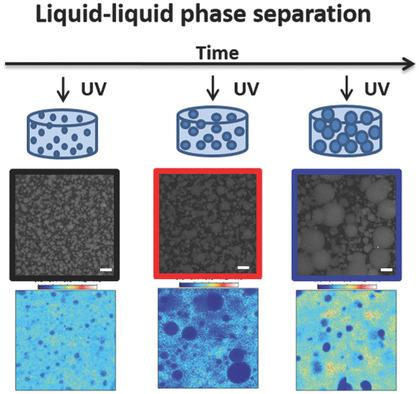Our official English website, www.x-mol.net, welcomes your feedback! (Note: you will need to create a separate account there.)
Microstructured Elastomer‐PEG Hydrogels via Kinetic Capture of Aqueous Liquid–Liquid Phase Separation
Advanced Science ( IF 15.1 ) Pub Date : 2018-03-12 , DOI: 10.1002/advs.201701010 Hang Kuen Lau 1 , Alexandra Paul 2, 3 , Ishnoor Sidhu 4 , Linqing Li 1 , Chandran R. Sabanayagam 5 , Sapun H. Parekh 3 , Kristi L. Kiick 1, 5
Advanced Science ( IF 15.1 ) Pub Date : 2018-03-12 , DOI: 10.1002/advs.201701010 Hang Kuen Lau 1 , Alexandra Paul 2, 3 , Ishnoor Sidhu 4 , Linqing Li 1 , Chandran R. Sabanayagam 5 , Sapun H. Parekh 3 , Kristi L. Kiick 1, 5
Affiliation

|
Heterogeneous hydrogels with desired matrix complexity are studied for a variety of biomimetic materials. Despite the range of such microstructured materials described, few methods permit independent control over microstructure and microscale mechanics by precisely controlled, single‐step processing methods. Here, a phototriggered crosslinking methodology that traps microstructures in liquid–liquid phase‐separated solutions of a highly elastomeric resilin‐like polypeptide (RLP) and poly(ethylene glycol) (PEG) is reported. RLP‐rich domains of various diameters can be trapped in a PEG continuous phase, with the kinetics of domain maturation dependent on the degree of acrylation. The chemical composition of both hydrogel phases over time is assessed via in situ hyperspectral coherent Raman microscopy, with equilibrium concentrations consistent with the compositions derived from NMR‐measured coexistence curves. Atomic force microscopy reveals that the local mechanical properties of the two phases evolve over time, even as the bulk modulus of the material remains constant, showing that the strategy permits control of mechanical properties on micrometer length scales, of relevance in generating mechanically robust materials for a range of applications. As one example, the successful encapsulation, localization, and survival of primary cells are demonstrated and suggest the potential application of phase‐separated RLP‐PEG hydrogels in regenerative medicine applications.
中文翻译:

液相-液相分离动力学捕获的微结构弹性体-PEG水凝胶
对于各种仿生材料,研究了具有所需基质复杂性的非均质水凝胶。尽管描述了此类微结构材料的范围,但很少有方法允许通过精确控制的单步处理方法来独立控制微结构和微尺度力学。在这里,报道了一种光触发的交联方法,该方法捕获了高度弹性的树脂弹性蛋白样多肽(RLP)和聚乙二醇(PEG)的液相分离的溶液中的微观结构。可以将各种直径的RLP富集结构域捕获在PEG连续相中,结构域成熟的动力学取决于丙烯酸化程度。通过原位高光谱相干拉曼显微镜评估两个水凝胶相随时间的化学组成,平衡浓度与由NMR测量的共存曲线得出的成分一致。原子力显微镜显示,即使材料的体积模量保持恒定,这两个相的局部机械性能也会随时间变化,这表明该策略允许在微米长度范围内控制机械性能,这与生成机械强度高的材料有关。一系列的应用程序。例如,已证明原代细胞的成功包封,定位和存活,表明相分离的RLP-PEG水凝胶在再生医学应用中的潜在应用。即使材料的体积模量保持恒定,也表明该策略允许在微米长度范围内控制机械性能,这与生成适用于各种应用的机械强度高的材料有关。例如,已证明原代细胞的成功包封,定位和存活,表明相分离的RLP-PEG水凝胶在再生医学应用中的潜在应用。即使材料的体积模量保持恒定,也表明该策略允许在微米长度范围内控制机械性能,这与生成适用于各种应用的机械强度高的材料有关。例如,已证明原代细胞的成功包封,定位和存活,表明相分离的RLP-PEG水凝胶在再生医学应用中的潜在应用。
更新日期:2018-03-12
中文翻译:

液相-液相分离动力学捕获的微结构弹性体-PEG水凝胶
对于各种仿生材料,研究了具有所需基质复杂性的非均质水凝胶。尽管描述了此类微结构材料的范围,但很少有方法允许通过精确控制的单步处理方法来独立控制微结构和微尺度力学。在这里,报道了一种光触发的交联方法,该方法捕获了高度弹性的树脂弹性蛋白样多肽(RLP)和聚乙二醇(PEG)的液相分离的溶液中的微观结构。可以将各种直径的RLP富集结构域捕获在PEG连续相中,结构域成熟的动力学取决于丙烯酸化程度。通过原位高光谱相干拉曼显微镜评估两个水凝胶相随时间的化学组成,平衡浓度与由NMR测量的共存曲线得出的成分一致。原子力显微镜显示,即使材料的体积模量保持恒定,这两个相的局部机械性能也会随时间变化,这表明该策略允许在微米长度范围内控制机械性能,这与生成机械强度高的材料有关。一系列的应用程序。例如,已证明原代细胞的成功包封,定位和存活,表明相分离的RLP-PEG水凝胶在再生医学应用中的潜在应用。即使材料的体积模量保持恒定,也表明该策略允许在微米长度范围内控制机械性能,这与生成适用于各种应用的机械强度高的材料有关。例如,已证明原代细胞的成功包封,定位和存活,表明相分离的RLP-PEG水凝胶在再生医学应用中的潜在应用。即使材料的体积模量保持恒定,也表明该策略允许在微米长度范围内控制机械性能,这与生成适用于各种应用的机械强度高的材料有关。例如,已证明原代细胞的成功包封,定位和存活,表明相分离的RLP-PEG水凝胶在再生医学应用中的潜在应用。



























 京公网安备 11010802027423号
京公网安备 11010802027423号